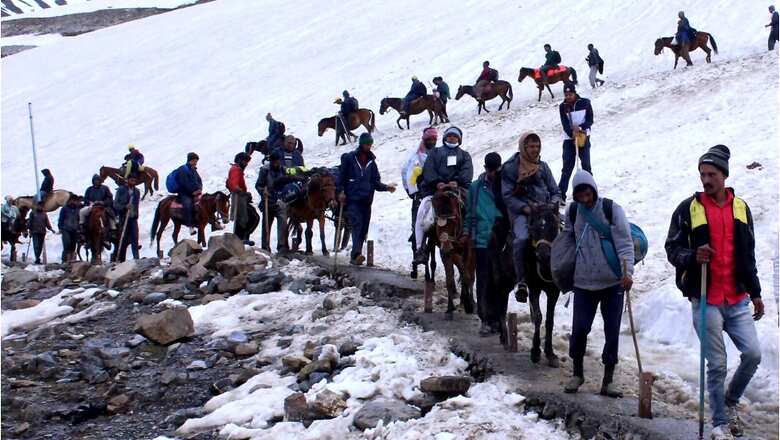Amarnath Yatra Integral to Kashmiri Ethos. Lakhs of Pilgrims Will Make Their Way Amid Tight Security

views
Kashmir is probably one of the most enigmatic places in the world, especially in terms of its rich culture and diversity of faiths. Over the centennials of its existence, this region has undergone more social, cultural and religious changes than most others, and yet has managed to retain a unique identity of its own. Its peoples and communities, be it Hindus, Muslims, Buddhists or Sikhs, have successfully co-existed and added to the serenity of its natural beauty, flora and fauna, and heritage.
Kashmiri ethos and culture are all-encompassing. Despite having faced centuries of socio-economic hardship with resilience and patience, its people have still managed to retain optimism and a remarkable sense of humour, promote their spiritual ethos and project a human and harmonious side that any society would be proud of.
“Sambandh” or “Association by way of linkage” best describes the Kashmiri way of life, their ethos and culture. Positive feelings like love and affection, as well as adverse emotions such as trauma and tragedy, horror or wonder, find unique and inimitable expression through spiritualism and religion. These are reflective of the enduring core human values of the gentle and peace-loving people of Jammu and Kashmir and their tenacity to accept and happily assimilate adversity.
There are several examples of Kashmir’s rich and diverse cultural and pluralistic religious ethos. Kheer Bhawani Temple is revered by Kashmiri Pandits who visit in large numbers during festivals. Muslims living close to the temple voluntarily extend help in making administrative arrangements for Hindu devotees making this event a symbol of communal harmony.
Sufism came to Kashmir in the 9th century and became immensely popular since it was a welcome alternative to the oppressive religious orthodoxy prevalent at that time. Sufism was a culture based on love, compassion, common identity, and submission to God regardless of caste and financial position and as such, gave everyone an equal chance to move away from rigidity, earn a livelihood, fight poverty and work towards social upliftment.
Also Read: Opinion: In Jammu and Kashmir, A War against Corruption is Underway
Amarnath Yatra or pilgrimage to a cave shrine dedicated to Lord Shiva also is an integral part of Kashmiri culture and ethos. This month-long pilgrimage period draws devout Hindus from all over the country and reaffirms the fact that Kashmir has always been an integral part of India with the same cultural and religious affinity. This pilgrimage not only is of spiritual significance to Hindus but is also of social, cultural and financial importance for the local Muslim population.
The porters, guides, pony owners, taxi drivers and hoteliers would wait for the whole year for the tourists and pilgrims to arrive as it is a good source of income. This pilgrimage would give a chance for the pilgrim to look within and do some soul searching. Besides the religious aspect, the Amarnath trek provides much-needed relief from the hectic city life and brings one closer to nature, thus opening the realm of the spiritual world.
A fortnight in the mountains in close association with nature also works wonders for one’s health. So, over the years, this annual pilgrimage beginning at the end of June and ending in the first week of August is anxiously awaited by all.
The upcoming yatra is being held after an interval of two years due to the Covid pandemic, and due to the prevailing heightened security threat poses a serious challenge to the security agencies. However, the Centre and the UT administration have pulled out all stops to ensure that this pilgrimage takes place without incident. Three high-level meetings, including two on security, have been held and presided over by Union Home Minister Amit Shah and for the first time, the government has decided to insure every pilgrim for Rs.5 lakh and give all of them unique Radio Frequency Identification (RFID) tags. Earlier RFIDs were given to vehicles only.
Arrangements have also been made to create a tented city, establish Wi-Fi hotspots and ensure proper lighting along the pilgrimage route. The government has also made arrangements for online Darshan of Baba Barfani, live telecasts of the morning and evening Aarti at the holy Amarnath Cave, besides organising religious and cultural programs at the base camp.
Anticipating a threat to yatris, the Central Ministry of Home Affairs and the UT administration have put in place a security grid that includes deployment of about 12,000 paramilitary troops and hundreds of Jammu and Kashmir Police personnel along the two pilgrimage routes (via Pahalgam and Baltal), and the use of drone cameras. About 8 lakh pilgrims are likely to undertake the pilgrimage, which is expected to end on August 11.
Despite the turmoil of militancy in Jammu and Kashmir, the importance of the Amarnath Yatra has never declined. Lakhs of pilgrims from all parts of the country visit the shrine every year regardless of the security threat. Even when terrorism was at its peak, the number of pilgrims was always more than what the government could allow due to security reasons and time constraints; it continues to be so and this year also, the Yatra will surely surpass all records.
The author is Editor of Brighter Kashmir, TV commentator, political analyst and columnist. The views expressed in this article are those of the author and do not represent the stand of this publication.
Read all the Latest Opinions here

















Comments
0 comment